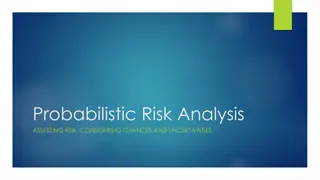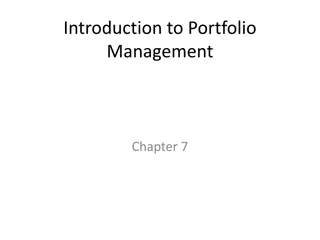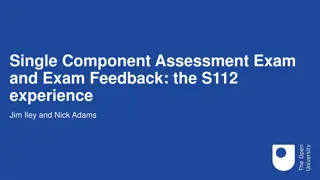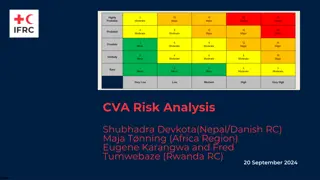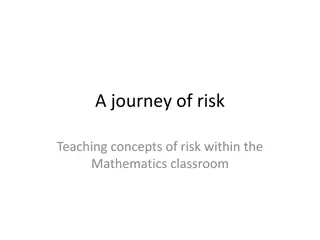Fundamentals of Risk Analysis Training Module
This training module on Risk Analysis covers the fundamentals, distinctive features between Quantitative and Qualitative Risk Analysis, various methodologies and approaches, and more. Learn about the process of determining the likelihood of risk in a project, investigating prospective risks, and managing uncertainties effectively. The module emphasizes understanding risk, analyzing probabilities, and implementing strategies to mitigate potential risks.
Download Presentation

Please find below an Image/Link to download the presentation.
The content on the website is provided AS IS for your information and personal use only. It may not be sold, licensed, or shared on other websites without obtaining consent from the author. Download presentation by click this link. If you encounter any issues during the download, it is possible that the publisher has removed the file from their server.
E N D
Presentation Transcript
e4f e4f- -network.eu network.eu Training module title Training module title: Risk Analysis "The European Commission support for the production of this publication does not constitute endorsement of the contents which reflects the views only of the authors, and the Commission cannot be held responsible for any use which may be made of the information contained therein."
Objectives and goals Objectives and goals At the end of this module you will be able to: Understand the fundamentals of Risk Analysis Learns the distinctive features between Quanti. & Qualitative Risk Analysis Familiarise with different methodologies and approaches to Risk Analysis "The European Commission support for the production of this publication does not constitute endorsement of the contents which reflects the views only of the authors, and the Commission cannot be held responsible for any use which may be made of the information contained therein."
Index of Content Index of Content Unit and sections Unit and sections UNIT UNIT 1 1: : Risk Section 1.1: Definition of Risk Analysis Section 1.2: Qualitative Risk Analysis Section 1.3: Quantitative Risk Analysis Section 1.4: Qualitative vs. Quantitative Analysis Risk Analysis Analysis UNIT UNIT 2 2: : Methodologies Methodologies and Section 2.1: Bow Ties Analysis Section 2.2: Risk Analysis Matrix Section 2.3: Risk register Section 2.4: SWIFT Analysis and approaches approaches to to Risk Risk Analysis Analysis "The European Commission support for the production of this publication does not constitute endorsement of the contents which reflects the views only of the authors, and the Commission cannot be held responsible for any use which may be made of the information contained therein."
Unit 1: Risk Analysis Unit 1: Risk Analysis Section 1.1 Section 1.1: : Definition of Risk Analysis Definition of Risk Analysis Risk analysis is the process of determining the likelihood of risk in a project. It investigates the uncertainty of prospective risks and how they might affect the project in terms of time, quality, and money if they occurred. How? How? analyst Why? Why? A determining what may go wrong. These disadvantages balanced against meter that assesses the chance of the event occurring. risk begins by Risk establishing the worthiness of a certain project or investment and the appropriate manage such risks. analysis is critical for must probability be a process(es) to "The European Commission support for the production of this publication does not constitute endorsement of the contents which reflects the views only of the authors, and the Commission cannot be held responsible for any use which may be made of the information contained therein."
Risk Register Risk Analysis Probability-Impact Index Qualitative Risk Analysis Risk Categorization Expert Judgement Sensitivity Analysis Decision Tree Analysis Scenario Analysis Quantitative Risk Analysis Latin Hyper cube Simulation Monte Carlo Simulation "The European Commission support for the production of this publication does not constitute endorsement of the contents which reflects the views only of the authors, and the Commission cannot be held responsible for any use which may be made of the information contained therein."
Risk Analysis Risk Analysis Section 1.2 Section 1.2: : Qualitative Risk Analysis Qualitative Risk Analysis The qualitative risk analysis is a risk assessment performed by project team specialists who use data from previous projects and their knowledge to determine the impact and likelihood value for each risk on a scale or risk matrix. Once risks have been identified and examined, a member of the project team is appointed as the risk owner for each risk. They are in charge of developing implementing response strategy. There is also an effect scale that ranges from one to five, having the most impact on the project. The risk will then be classified as source- or effect-based. The rated from zero to one. That is, if the likelihood of the risk occurring in the project is .5, it has a 50% chance of occurring scale is typically with five and risk a "The European Commission support for the production of this publication does not constitute endorsement of the contents which reflects the views only of the authors, and the Commission cannot be held responsible for any use which may be made of the information contained therein."
Risk Analysis Risk Analysis Section 1.3 Section 1.3: : Quantitative Risk Analysis Quantitative Risk Analysis The quantitative risk analysis is a statistical examination of the impact of the identified risks on the entire project. This enables project managers and team leaders to make choices with less ambiguity and aids the risk-control process. Quantitative risk analysis analyses the project outcomes calculates the likelihood of attaining objectives. This making, especially during the project phase when ambiguity. aids decision- various and It managers in developing realistic cost, schedule, and scope objectives. assists project planning there is project "The European Commission support for the production of this publication does not constitute endorsement of the contents which reflects the views only of the authors, and the Commission cannot be held responsible for any use which may be made of the information contained therein."
Section 1.4: Section 1.4: Qualitative vs. Quantitative Analysis Qualitative vs. Quantitative Analysis Qualitative Analysis process numerical and quantitative evaluations to identify and assess hazards. Quantitative Analysis involves numerical evaluations. Analytical that does not use It and quantitative It is not required for all projects; in some kinds of them it can be avoided. It can be done in every kind of project. It gives a subjective evaluation of probability and impact. Gives probabilistic estimate of time and costs an objective evaluation and a Easy to perform. It s more time consuming than a qualitative analysis. No specific software or tools required. It may require some special tools to be realised. "The European Commission support for the production of this publication does not constitute endorsement of the contents which reflects the views only of the authors, and the Commission cannot be held responsible for any use which may be made of the information contained therein."
Summing up Summing up Risk Analysis Risk Analysis Types of risk analysis Types of risk analysis The process of determining the likelihood of risk in a project. Qualitative Quantitative Qualitative Qualitative Risk Analysis Risk Analysis Determines the impact and likelihood value for each risk on a scale or risk matrix. Quantitative Quantitative Risk Analysis Risk Analysis Quantitative vs. Quantitative vs. Qualitative Qualitative Statistical examination of the impact of the identified risks on the entire project. Analytical vs. numerical Subjective vs. objective "The European Commission support for the production of this publication does not constitute endorsement of the contents which reflects the views only of the authors, and the Commission cannot be held responsible for any use which may be made of the information contained therein."
Unit 2: Methodologies and approaches to Risk Analysis Unit 2: Methodologies and approaches to Risk Analysis The approaches The approaches Several risk analysis approaches exist to assist managers in the analysis and decision-making process. Bow Ties Analysis Risk Analysis Matrix ( + Risk Register, i.e. protocols and responsabilities) SWIFT Analysis "The European Commission support for the production of this publication does not constitute endorsement of the contents which reflects the views only of the authors, and the Commission cannot be held responsible for any use which may be made of the information contained therein."
Unit 2: Methodologies and approaches to Risk Analysis Unit 2: Methodologies and approaches to Risk Analysis Section 2.1: Section 2.1: Bow Ties Analysis Analysis Bow Ties The Bow Tie Analysis is a graphical depiction of new suitable pathways leading to risk prevention and safety that could be needed at organisation level, or per any given function. Consequences Causes Event measures Before After process / "The European Commission support for the production of this publication does not constitute endorsement of the contents which reflects the views only of the authors, and the Commission cannot be held responsible for any use which may be made of the information contained therein."
Unit 2: Methodologies and approaches to Risk Analysis Unit 2: Methodologies and approaches to Risk Analysis Section 2.2: Section 2.2: Risk Analysis Matrix Risk Analysis Matrix The risk analysis matrix ranks the severity of any given risk based on the likelihood and impact of the disruption associated. IMPACT (aka RISK CRITERIA) Negligible Marginal Critical Catastrophic PROBABILITY Certain Likely Its primary goal is to assist managers in prioritizing risks and developing a risk management includes the appropriate resources and tactics for risk mitigation. Possible Unlikely strategy that Rare "The European Commission support for the production of this publication does not constitute endorsement of the contents which reflects the views only of the authors, and the Commission cannot be held responsible for any use which may be made of the information contained therein."
Unit 2: Methodologies and approaches to Risk Analysis Unit 2: Methodologies and approaches to Risk Analysis Section 2.3: Section 2.3: Risk register Risk register A risk register is a repository in which outputs of risk processes are recorded. Information in a risk register can include the person responsible for managing the risk, probability, impact, risk score, planned risk responses, and other information used to get a high-level understanding of individual risks. management Source: PMP Management Book, Seventh Edition, July 2021. "The European Commission support for the production of this publication does not constitute endorsement of the contents which reflects the views only of the authors, and the Commission cannot be held responsible for any use which may be made of the information contained therein."
Unit 2: Methodologies and approaches to Risk Analysis Unit 2: Methodologies and approaches to Risk Analysis Section 2.4: Section 2.4: Swift Analysis Swift Analysis SWIFT is an acronym that stands for Structured What If Technique. SWIFT combines a pre-set of guidewords (such as scheduling, amount, etc.) with participant-generated prompts that frequently start with questions like "what if?" or "how could? ". employs structured brainstorming, which It is a risk analysis strategy that focuses on detecting possible hazards connected modifications. with project plan With the aid of the guidewords and "what if?" questions, the facilitator invites the group to bring up and discuss issues like: Known risks Risk sources and drivers Previous experience, successes and incidents Known and existing controls Regulatory requirements and constraints As the term implies, team members must generate as many what if questions as possible in order to identify all potential hazards. "The European Commission support for the production of this publication does not constitute endorsement of the contents which reflects the views only of the authors, and the Commission cannot be held responsible for any use which may be made of the information contained therein."
Summing up Summing up Methods for Methods for Risk Analysis Risk Analysis Bow Ties Analysis Risk Analysis Matrix Risk Register SWIFT Analysis "The European Commission support for the production of this publication does not constitute endorsement of the contents which reflects the views only of the authors, and the Commission cannot be held responsible for any use which may be made of the information contained therein."
e4f e4f- -network.eu network.eu Thank you! Thank you! "The European Commission support for the production of this publication does not constitute endorsement of the contents which reflects the views only of the authors, and the Commission cannot be held responsible for any use which may be made of the information contained therein."







